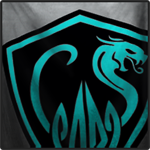Edit: Now with new stuff (at the end).
TL;DR: With a 25% jam probability, the UAC/5 dealt 3.95 DPS on double-shot mode, which was lower than the single-shot value of 4.55. Now, with a 15% probability, it deals 5.23.
Based on experience fighting with and against the UAC/5, it seems to me that it is now moderately overpowered. I present some statistical analysis to support this conclusion and to clear up for the community how to calculate its average DPS, which I don't think has been done before. Basically, my argument for its being overpowered rests on the idea that it was good before and is now significantly better.
First, some definitions:
C = cooldown time for single-shot mode (currently 1.1 s)
D = damage per shot (currently 5)
J = jam probability (between 0 and 1; currently 0.15 and was 0.25)
U = unjam time (currently 5 s)
When you hold down the fire button for double-shot mode, the weapon always fires one shot immediately. It then waits C/2 seconds, and one of two things may happen:
- There is a probability J that the weapon will jam and be ready to fire again in U seconds. No ammo is used, and no heat is generated.
- There is a probability 1-J that the weapon will fire another shot and be ready to fire again in C/2 seconds.
If we make a large number N of double-shot attempts, we expect that there will be J*N failures and (1-J)*N successes. The total damage will be J*N*D+(1-J)*N*2*D, while the time elapsed will be J*N*(C/2+U)+(1-J)*N*C. We can divide the two to find the long-run average DPS. After canceling the N's and combining like terms, we get
DPS = (2-J)*D/((1-J/2)*C+J*U).
Using this formula, we find DPS = 5.23 for J = 0.15 and DPS = 3.95 for J = 0.25. In single-shot mode, DPS = 5/1.1 = 4.55. For comparison, the AC/20 puts out 20/4 = 5 DPS.
Verification: In Testing Grounds, it took 373.6 s to fire 397 shots, for 5*397/373.6 = 5.31 DPS, which is greater than the prediction by about 2%.
Another interesting phenomenon is visible when looking at the expected total damage over time. Rather than tediously working out the theory, I wrote a MATLAB program that simulates (using a random number generator) the UAC/5 behavior described above and records the total damage dealt over time. Each of the curves below is the average of 10,000 separate runs with a single gun.

In both cases, the expected DPS exceeds the long-run trend to about the same degree up to the 2-second mark. After this, the old UAC/5 goes through a roughly 5-second period of lower-than-average DPS before settling into the long-run trend. By contrast, the new UAC/5 continues to deal damage at the elevated rate up to about the 4-second mark before settling smoothly into the long-run trend.
With the old UAC/5, one could expect a 2-second period of elevated damage, followed by a 5-second period of reduced damage. It would make sense, therefore, to use burst fire when emerging from cover for a quick attack or when engaging a target that would only be visible for a few seconds. Otherwise, you would get not only lower DPS on average in a sustained fight, but also a 5-second window of even worse performance at the beginning--right when you would like to dish out a lot of damage and get a quick kill.
By contrast, burst fire with the new UAC/5 is great for both short and sustained attacks. Extra damage can be pushed out in the initial stages for a (hopeful) quick kill, and, if this doesn't work, one tends to be right at the long-run DPS trend, which is, furthermore, better than the single-shot value.
Conclusion: There are no longer any serious drawbacks to using double-shot mode. The risk of jamming should give a better alpha strike at the cost of reduced long-run DPS, but it now improves both numbers. It also improves everything in between.
It could be argued that the possibility of getting nothing at all and having to wait 5-ish seconds introduces uncertainty that counteracts the added DPS. However, with 2-3 guns, I find that the results are now pretty uniform, enough so that simply assuming I will have the damage and going on the offensive works in the vast majority of cases. Also, it is usually possible to monitor the guns' performance and duck behind cover when they jam, so that maximum DPS is inflicted when actually in contact with the enemy.
Looking at my cumulative damage graph, it occurs to me that the results can be presented more intuitively if we think in terms of the improvement granted by double-shot mode over single-shot mode. Following this line of reasoning, what single-shot mode gives you is D damage every C seconds, and what you hope double-shot mode gives you is 2*D damage every C seconds, so it would make sense just to sample the data every C seconds. What happens in between doesn't matter all that much. Doing this produces the graph below.

The black and red parts are just a smoothed version of the earlier plot; I have also included the single-shot damage trend as a dashed black line. The green lines are for a hypothetical UAC/5 with C = 1.3, J = 0.225, and U = 7.5. Based on my experience, the single-shot rate of the UAC/5 is probably a bit too fast, and the rate of the AC/5 is probably a bit too low; furthermore, Russ has stated that the UAC/5 is just an AC/5 with the ability to double tap at risk, so assigning them both the same base cooldown seems justified. It then remains to adjust the J and U values so that something like the old burst DPS is achieved along with a similar long-run DPS decrease. My only concern is that the 7.5-second unjam is too long, but the chances of a jam are about 2 in 9, and the purpose of double-shotting is to produce a short alpha strike, so it may be OK.
It's also interesting to look at dividing the average cumulative damage on double-shot mode by the cumulative damage on single-shot mode to see how much of a relative advantage double-shotting offers for a given UAC/5. This is shown below for the new and old UAC/5, as well as the hypothetical one described above. For the current J = 0.15 autocannon, double-shotting is clearly preferable to single-shotting.

Finally, if you require that average double-shot DPS be less than single-shot DPS, you can (using the formula above and with some simple algebra) come up with
J > 1/(1/2+U/C).
For U = 5 and C = 1.1 (the current values), this means that J > 19.82%, as Buso Senshi Zelazny found graphically below.
At the suggestion of Itsalrightwithme, I have computed error bars for the cumulative damage graphs above. Each plot is for a different number of guns, but the cumulative damage-per-gun is shown (instead of total damage) to allow better comparison. The plots show the "interdecile range", i.e., you have a 10% chance of getting cumulative damage below the black brackets, 10% above, and 80% within; the black line is the average figure. The red line shows the single-shot UAC/5 trend, and the blue line is the AC/5 trend. As expected, the spread lessens as the number of guns increases. Each was computed from 50,000 trials.








Post-patch (9/17) analysis follows:
The new average long-run DPS is 3.83, which is only 15% above that of the AC/5.
Here are the same plots as above, but for the new UAC/5 with C = 1.5 and J = 0.2. The single-shot rates of the AC/5 and UAC/5 now correspond, so I have taken away the blue line. The error bars still show the interdecile range.




Instead of the spread between the 10th and 90th percentiles, we might want to see the 20/100 spread. In other words, the top of the error bar is the maximum possible damage, and the bottom is the amount of damage that we are 80% confident that we will meet or exceed.




With 3+ guns, we can be ~80% confident that we will meet or exceed the single-shot damage total over 15 seconds of continuous firing. With 4 guns, we can be 90% confident that we will meet or exceed the single-shot total over a 3-second burst.
Edited by Amaris the Usurper, 24 September 2013 - 01:03 PM.






























